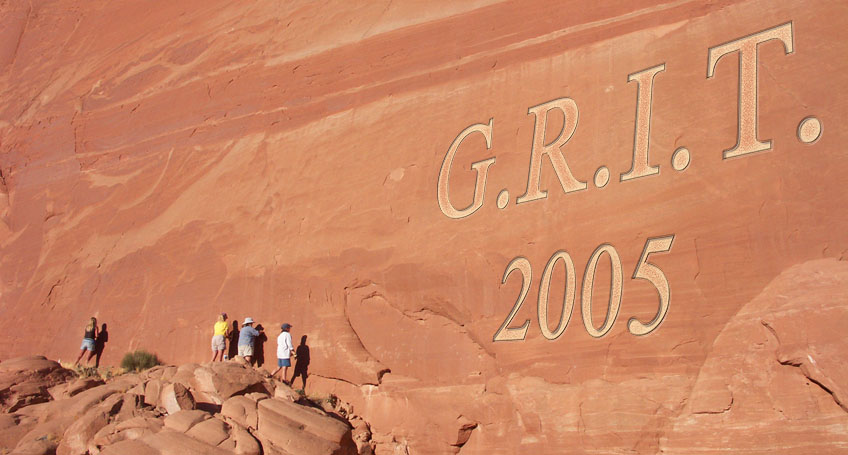
G.R.I.T. Trip Report, 2005
What It Is
G.R.I.T. stands for the Graffiti Removal and Intervention Team, a volunteer program of the National Park Service wherein volunteers participate in the removal of graffiti that careless visitors have painted on or carved into the rock walls of Lake Powell, in the Glen Canyon National Recreation Area spanning portions of Arizona and Utah. For a period of five days, the NPS provides, at no charge to volunteers, a houseboat and fuel, tools for graffiti removal, and a runabout boat 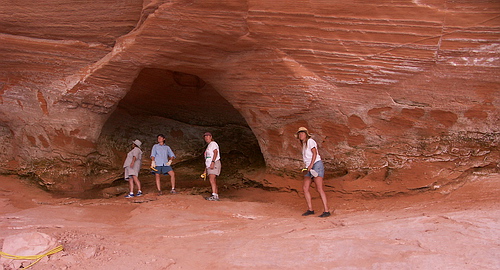 for local area travel while the houseboat is beached. In exchange, volunteers agree to work a minimum of 24 hours during those five days on graffiti abatement activities. I served as a captain in this program in October 2005 for a group of four volunteers.
for local area travel while the houseboat is beached. In exchange, volunteers agree to work a minimum of 24 hours during those five days on graffiti abatement activities. I served as a captain in this program in October 2005 for a group of four volunteers.
See also the trip report for 2004, when I had served on three separate trips.
G.R.I.T. volunteers admire their work in
a cave at the back of Rock Creek Bay:
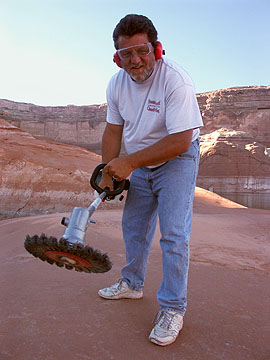 The Machine
The Machine
The approved method of graffiti removal relies on wire brushes and elbow grease. Although that method can produce the most aesthetically pleasing results, it simply can’t make it for some of the huge graffiti sites at Lake Powell, considering just how much graffiti there can be. And a power washer or sand blaster still isn’t going to make it into the NPS budget this year or next, never mind the problem of how to schlep such a contraption up the hill to the graffiti.
So last year I bought a gasoline-powered weedwhacker and jury-rigged a wire brush to the end where the nylon string had originally been. This year, with thanks to George Montplaisir at GT Machining in Campbell, CA, I have a custom nut that securely fastens the wire brush, and it works great. Look out graffiti - now I have a gasoline powered wire brush!
This year I was able to get a picture taken showing the business end
of my graffiti whacker and the specialized nut George made for me:
When I first tried it last year, “The Machine” could be too fast and too rough on the rock, and it demands quite a bit of practice not to make the graffiti removal worse than the original graffiti. But eventually I learned to operate it somewhat artistically, and over the course of the several volunteer trips it removed all the graffiti at a few formerly impossibly huge sites. Since its results are not quite as pleasing as that achieved by long and arduous hand work, “The Machine” should be viewed as a first step in the removal process, and is particularly well suited for large, deep, or extensive carvings.
Areas Visited This Trip
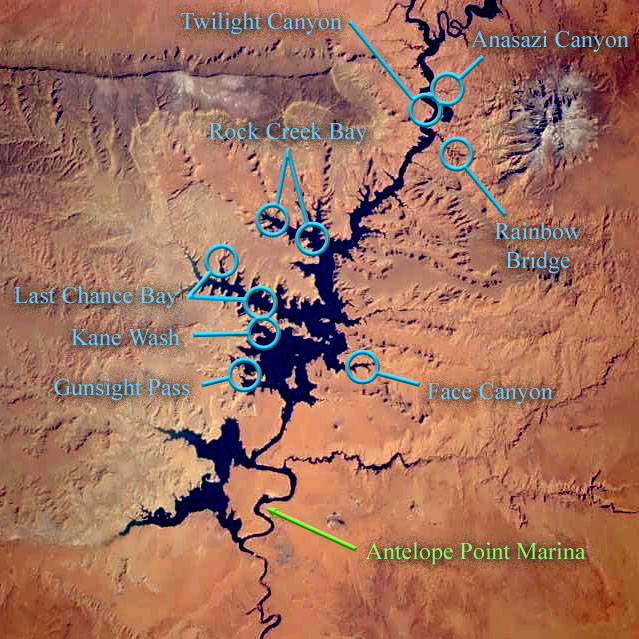
I have marked this space shuttle photograph of the lower lake with the locations where we removed graffiti. In addition to a large graffiti site in Kane Wash, we also cleaned areas of Anasazi Canyon, Rock Creek Bay, Last Chance Bay, Face Canyon, Twilight Canyon, Gunsight Pass, and in a special treat for us, we were allowed up to the back side and cleaned some despicable graffiti off of Rainbow Bridge itself.
The 2005 Trip
Although trips vary from one another and other captains may run their trips differently from I do, the 2005 GRIT trip with me concentrated on newly inflicted graffiti that I had seen during my vacation time.
- 1st day
After introductions and orientation to the houseboat, safety instruction, and a welcoming speech by NPS rep Lisa Dittman, we got underway from our home base at Antelope Point Marina. I had several target sights in mind, where I had seen recent graffiti to clean. We motored up lake and anchored the houseboat at a nice site on the main channel near the mouth of Rock Creek Bay, which was to serve as a somewhat central location from where forays to those sites could be launched. After lunch, we motored around Rock Creek Bay for a few hours of removal. A small island, a cave, and a wall accessible only by boat received our cleaning touches. Then back to the houseboat for a great dinner, some stargaizing, and we were ready for bed.
- 2nd day
This day was an all-day affair uplake. I had previously seen some fresh graffiti and fake “ruins” near Twilight Arch, so we headed there, but stopped for a sightseeing side trip to Rainbow Bridge. The first-timers to Lake Powell appreciated that. But that turned into a full-fledged graffiti removal operation when NPS Interpretive Specialist Chuck Smith showed us some graffiti on the Bridge itself, along with others in a nearby alcove. It was a special treat for us to be allowed into the closed area through and behind the Bridge to clean graffiti off its flanks. We had to be careful not to disturb historic graffiti placed by Zane Grey and others, as we cleaned off the modern vandalism. Chuck was most appreciative of our efforts and announced us as local celebrities and heroes to all the other visitors to the area who would listen. We then continued to Twilight Canyon and removed the new graffiti there. To make it the fullest of days, I showed the volunteers Eye Arch, the ultra-narrow Secret Canyon, and my favorite spot in Anasazi Canyon, where we removed a bit of graffiti also. We just barely made it back to the houseboat by nightfall.
- 3rd day
Sometimes there was more work to be done on the Knob. On other trips, we looked for and eradicated graffiti in other locations. All in all, we removed graffiti in Gunsight Canyon, Rock Creek Bay, Last Chance Bay, Face Canyon, Antelope Canyon, and the side of Lone Rock. In addition, we ended up checking out West Canyon, Kane Creek, Kane Wash, and several of the smaller canyons surrounding Dangling Rope Marina. Hiking in Face Canyon in particular was interesting because of its long narrow slot canyon recently revealed by the receding lake waters.
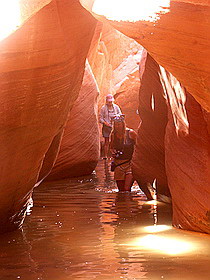
Some views of our hikes:
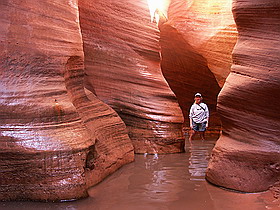
- 4th day
Like the day before, we split the day between graffiti removal and canyon exploration. We also spent some PR time in the area, meeting with other houseboaters camped nearby, and telling them about the GRIT program. The third trip was different, because we had discovered a heartbreakingly huge graffiti panel in Rock Creek Bay which was situated right of the top of an ancient Anasazi rock art site. We worked all day on this panel, and by the end, with the aid of “The Machine,” we had removed nearly all of the 2000+ square feet of graffiti.
Aerial view of the Rock Creek alcove: - 5th day
The fifth day not as leisurely as had been on other trips. completed our required work time obligations by then. A morning swim, a fine breakfast, and we broke camp and eventually made it back to the marina. After cleaning the boat for the next crew and filling out the program evaluations, we bid our farewells.
Morning coffee amid the scenery
10/11: RC, island, cave
10/12:rb, tw, anasazi, secret
10/13 rc end, lc
10/14: wetherill, kane
10/15 Padre, gunsight, Face
Volunteer!
This program could always use additional energetic and dedicated volunteers. If you would like to take part in the GRIT program, check out the program web page at the National Park Service, and then follow the instructions there. Tell NPS Volunteer Coordinator Betsy Scroggs I sent you!
Special note for prospective GRIT captains:
In 2005 there were only two volunteer boat pilots to run all the GRIT trips. On top of that, my schedule allowed me to run only one trip while the other pilot ran all the rest of them. I’m sure there are some of you who could step up to this task. Before a prospective pilot is allowed to operate a government-owned boat, he or she must first attend and pass the Department of Interior Motorboat Operator Certification Course (DOI-MOCC), as well as other training specific to GRIT. Unfortunately, the NPS budget doesn’t allow for this course to be offered all the time, or even every year, as there was none offered in 2005 for potential GRIT pilots. I was fortunate enough to attend this course in May of 2004, in a session held at Lake Powell. If you have the inclination to fulfill the captain’s role, and more importantly, the time available to the program to make it worthwhile for the NPS to train you, then be sure to let Betsy know this.
Return to main Lake Powell page
All images and content copyright ©2005 David Herberg. All rights reserved.
This page last modified on 25-Jan-2006
| You are visitor | since January 8, 2006 |